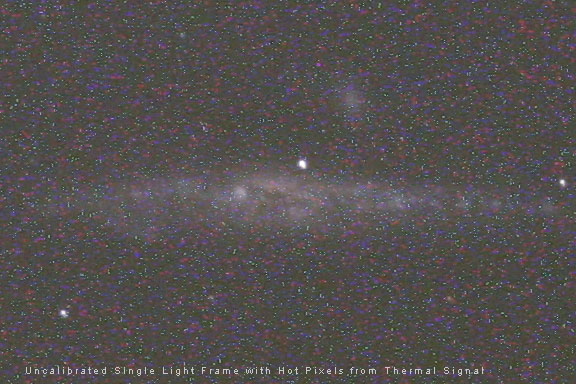The most common type of incorrect calibration involves using a dark frame that does not match the temperature of the light frame. Since the temperatures were different, each has a different amount of thermal signal, visible as hot pixels and color blotches in the background.
If the temperature of the dark frame is hotter than that of the light frame, the thermal signal will be greater and the hot pixels brighter. When it is subtracted, it will leave behind "dark holes" where the hot pixels were, as can be seen in the mouse-over comparison below.
Mouse-Over

|
|
Hold your mouse cursor over the image of galaxy NGC 4631 to see a comparison between the original un-calibrated light frame with hot pixels from thermal signal, and the incorrectly calibrated light frame with dark holes. If you look carefully, you will see that the dark holes are exactly where the hot pixels were. This is caused when the dark frames temperature is hotter than the light frame. The hot pixels are brighter in the dark frame, leaving behind a dark spot when subtracted from the light frame.
|
- Solution:
- Theoretically, the way to fix this problem is to make sure that the temperature of the darks exactly matches the temperature of the lights. In practice, this is difficult with DSLR cameras. Because they are not cooled with a regulated cooler, they will heat up continuously during use for an hour or two until the internal temperature stabilizes. The temperature and thermal signal will be different in nearly every frame.
- One solution is to use an astronomical image processing program like Images Plus that is specifically made for DSLR cameras. Images Plus offers a feature during calibration that will examine the thermal signal in the image and automatically scale it to match the thermal signal in the light frames, correctly subtracting it even though the temperatures were different. It works amazingly well.
- Another solution is to manually match the temperature of each light frame to a dark frame, or stack of dark frames. With the latest model cameras, the internal temperature is recorded in the EXIF data written into the image file. A program like Dark Library will examine the EXIF data and sort files by temperature. They can then be matched exactly during calibration in a program like DeepSky Stacker.
Likewise, if the dark frame is taken at a lower temperature than the light frame, it will have less thermal signal. In this case, artifacts of "light" holes can be left behind.
Dark Hole Smearing
If incorrect calibration is applied to each individual light frame in a master light frame, and the light frames do not align exactly, the dark holes will smear when the light frames are aligned together and stacked.
There is almost always some movement between frames due to flexure, even when guiding is employed. If no guiding is used, the movement may be even more, causing even more smearing.
Smearing occurs because the thermal signal, and the incorrectly calibrated dark holes, are in the same place in each frame. The stars, however, move from frame to frame because of periodic error in the tracking and flexure in the scope and mount. Therefore, the stars need to be aligned when the individual light frames are stacked. To align them, each frame is moved. When the stars line up after alignment, the thermal signal is now in a different place in each frame. The dark holes now appear smeared because they have moved from frame to frame when the stars were aligned.
Mouse-Over

|
|
Hold your mouse cursor over the image of NGC 4631 to see the effect of dark hole smearing between a single light frame that was incorrectly calibrated with a dark frame that did not match in temperature, and a stack where each individual light frame was aligned.
|
|
Problem: Improper Calibration - The Bottom Line
Because DSLR cameras heat up during use, it is difficult to match the temperature of dark frames to the temperature of light frames.
If they don't match exactly, artifacts can be left behind in the form of black holes or light specks after calibration.
The best way to deal with this problem is to use an astronomical image processing program that automatically adjusts the thermal signal in the dark frame to match the light frame.
|